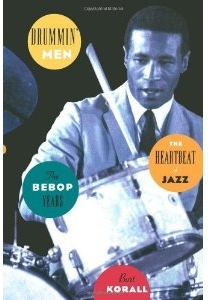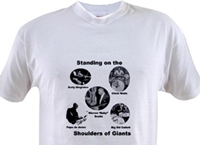For research, however, my main three resources are these two books and video. I am not limited to them, but they are the first places to which I turn when I want to look up or verify information.
The books are both by Burt Korall who has done meticulous research. The first is Drummin' Men: The Heartbeat of Jazz The Swing Years

This 400 page book has served me well as a research tool. I have cited it more than a few times in this blog. I have also discovered facts about my own idols and influences that I have not found elsewhere.
One example of a discovered fact (from the book) is that Ray Bauduc assisted in the design of the venerable Speed King bass drum pedal, as well as assisted Zildjian in the design of the swish cymbal.
As for biographies, I have found every one to be devoid of hyperbole or questionable assertions in the swing edition, and am pleased by the drummers who were included.
Unlike the second book, this book is organized in a linear fashion that is strictly chronological.
The second book by Korall is Drummin' Men--The Heartbeat of Jazz: The Bebop Years

What I love about this (and the companion book) is Korall is not only a drummer, but a great historian and overall musician. He does not confine his writing to drums and drumming, but digs into the music itself. Take any chapter and you are treated to a dissertation on the music and musicians who created the music the subject drummer played, including accolades for the other instrumentalists on the recordings cited.
More importantly, Korall can write prose that is engaging and descriptive. Consider one passage in which he describes Art Blakey's uncharacteristically subdued playing on Thelonious Monk Trio: Rudy Van Gelder Remasters. He describes it as Blakey painting in pastels while retaining an underlying rhythm and source of light. Definitely not the common biography lingo that is dry and devoid of color.
Another big plus - in my opinion - is the inclusion of Stan Levey. Just about every history of bebop overlooks him, yet Levey was backing Dizzy at the tender age of 16, and - along with Kenny Clarke and Max Roach - made significant contributions to the bebop drum vocabulary. In fact, Levey was Bird's room mate for a year and was a fixture on the NY and LA scenes.
I also love the structure and sequencing of the book. After a very brief chapter, Bebop, that sets the tone for the rest of the book, Korall divides the book into logical sections.
Swing to Bop covers the visionaries - Papa Jo Jones and Big Sid Catlett - who laid the groundwork for the new drumming style that made bebop possible. While most of us credit Kenny Clarke, Korall makes a good case for Papa Jo as the root. That does not diminish Clarke's contributions in my opinion.
The next section - Transitional Figures - is my personal favorite section for a number of reasons. First, it contains important drummers, some of whom I did not know about, and three I hold in the highest esteem. Those are Denzil Best, J. C. Heard and Shadow Wilson. Of the three Wilson is one of the most elusive figures in that there is so very little written about him. Yet, he occupies an important place in the transition from swing to bop, and was held in the highest regard by practically everyone, including Papa Jo Jones. Also, the nine full pages in this book devoted to Wilson contain more information than any other single source I have found. To me, that alone made this book worth every penny.
Innovators is the heart of the book. All of the major players who defined bebop (and hard bop) are covered. There are a few surprises: Don Lamond who I more associate with big bands, and Shelly Manne who was more a West Coast jazz pioneer. Still, both do belong in this section in my opinion.
The last two sections cover the 1950s and other significant figures and there are no surprises for the most part. Philly Joe Jones, Art Taylor, Mel Lewis and a few others are covered in sufficient detail.
What brings this book alive and makes it a cohesive blend of fact, history, music and opinion are the first hand accounts of other musicians (and in some cases family members) for each drummer. Those, combined with Korall's deep knowledge of music, drumming and his own meticulous research make this an invaluable companion to amateur historians like myself. Korall's notes, bibliography, discography and section on interviewees add more value to this book.
The final resource is a DVD titled Legends of Jazz Drumming

This is not your typical compilation of drum solos such as Classic Drum Solos and Drum Battles. While it does contain performances and a fair share of jaw dropping solos, it is a history of the evolution of drum kit playing and some of the drummers who were either pioneers or innovators.
Indeed, the late, great Louis Bellson narrates much of this video, with another great - Roy Haynes - providing his commentary and insights. Jack DeJohnette joins Louis and Roy on the second half of this two hour video, and adds even more to the rich tapestry of this slice of history.
What I especially like about this video is the wide coverage of early drummers, including the root of all modern players: Baby Dodds. But that was expected. I was delighted to see Tony Sbarbaro (aka Tony Spargo), Paul Barbarin and Zutty Singleton included in the discussion of early drummers. And at the end of each era discussed a listing of relevant, influential drummers from the period that there was no room to discuss in the video was provided. This ensured that viewers understood that choices has to be made when planning the video regarding who would and would not be included.
Another great thing about this video is you are treated to Louis Bellson's and Roy Haynes's own recollections. Both were pioneers of aspects of drummming (Louis is credited with the development and use of double bass drum kits and Roy was one of the pioneer bebop drummers who played with Charlie Parker, Thelonious Monk and Dizzy Gillespie - among others!) Their commentary and personal recollections provided invaluable insights into not only the drummers under discussion, but also the period, music and other musicians.
I personally think the choices of who to spotlight in the video were wise and on the mark. There was one omission that I lamented - Stan Levey - who was a true pioneer in his own right (and who was alive when the video was made.) However, I understand the constraints of a video (this first came out on two VHS tapes), so that omission is not a fatal flaw and was later rectified when Stan Levey - The Original Original was released.
Although the scope of this post is on the two books and DVD cited, there is one other DVD I want to recommend: Steve Smith's Drumset Technique/History of the U.S. Beat. Smith, in one of the two DVDs in this set, provides a brief discussion and a longer demonstration of drum kit playing styles ranging from ragtime to modern rock.
All of these sources greatly add to the tapestry of history.



No comments:
Post a Comment